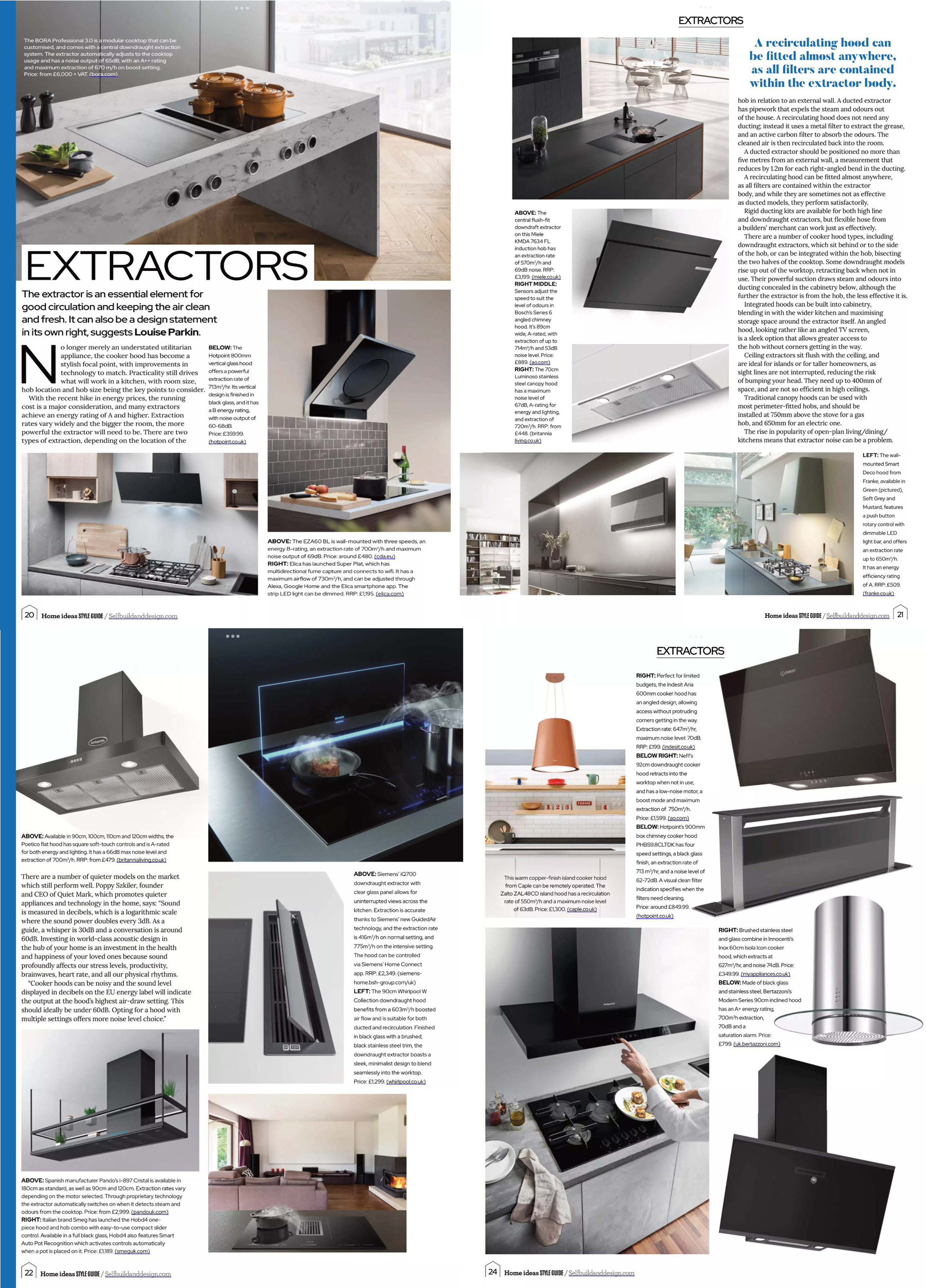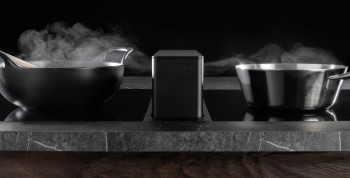EXTRACTORS


EXTRACTORS
The extractor is an essential element for good circulation and keeping the air clean and fresh. It can also be a design statement in its own right, suggests Louise Parkin.
There are a number of quieter models on the market which still perform well. Poppy Szkiler, founder and CEO of Quiet Mark, which promotes quieter appliances and technology in the home, says:
"Sound is measured in decibels, which is a logarithmic scale where the sound power doubles every 3dB. As a guide, a whisper is 30dB and a conversation is around 60dB. Investing in world-class acoustic design in the hub of your home is an investment in the health and happiness of your loved ones because sound profoundly affects our stress levels, productivity, brainwaves, heart rate, and all our physical rhythms.
"Cooker hoods can be noisy and the sound level displayed in decibels on the EU energy label will indicate the output at the hood's highest air-draw setting. This should ideally be under 60dB. Opting for a hood with multiple settings offers more noise level choice."

No longer merely an understated utilitarian appliance, the cooker hood has become a stylish focal point, with improvements in technology to match. Practicality still drives what will work in a kitchen, with room size, hob location and hob size being the key points to consider.
With the recent hike in energy prices, the running cost is a major consideration, and many extractors achieve an energy rating of A and higher. Extraction rates vary widely and the bigger the room, the more powerful the extractor will need to be. There are two types of extraction, depending on the location of the hob in relation to an external wall. A ducted extractor has pipework that expels the steam and odours out of the house. A recirculating hood does not need any ducting instead it uses a metal filter to extract the grease, and an active carbon filter to absorb the odours. The cleaned air is then recirculated back into the room.
A ducted extractor should be positioned no more than five metres from an external wall, a measurement that reduces by 1.2m for each right-angled bend in the ducting.
A recirculating hood can be fitted almost anywhere, as all filters are contained within the extractor body, and while they are sometimes not as effective as ducted models, they perform satisfactorily.
Rigid ducting kits are available for both high line and downdraught extractors, but flexible hose from a builders' merchant can work just as effectively.
There are a number of cooker hood types, including downdraught extractors, which sit behind or to the side of the hob, or can be integrated within the hob, bisecting the two halves of the cooktop. Some downdraught models rise up out of the worktop, retracting back when not in use. Their powerful suction draws steam and odours into ducting concealed in the cabinetry below, although the further the extractor is from the hob, the less effective it is.
Integrated hoods can be built into cabinetry, blending in with the wider kitchen and maximising storage space around the extractor itself. An angled hood, looking rather like an angled TV screen, is a sleek option that allows greater access to the hob without corners getting in the way.
Ceiling extractors sit flush with the ceiling, and are ideal for islands or for taller homeowners, as sight lines are not interrupted, reducing the risk of bumping your head. They need up to 400mm of space, and are not so efficient in high ceilings.
Traditional canopy hoods can be used with most perimeter-fitted hobs, and should be installed at 750mm above the stove for a gas hob, and 650mm for an electric one.
The rise in popularity of open-plan living/dining/kitchens means that extractor noise can be a problem.
There are a number of quieter models on the market which still perform well. Poppy Szkiler, founder and CEO of Quiet Mark, which promotes quieter appliances and technology in the home, says:
"Sound is measured in decibels, which is a logarithmic scale where the sound power doubles every 3dB. As a guide, a whisper is 30dB and a conversation is around 60dB. Investing in world-class acoustic design in the hub of your home is an investment in the health and happiness of your loved ones because sound profoundly affects our stress levels, productivity, brainwaves, heart rate, and all our physical rhythms.
"Cooker hoods can be noisy and the sound level displayed in decibels on the EU energy label will indicate the output at the hood's highest air-draw setting. This should ideally be under 60dB. Opting for a hood with multiple settings offers more noise level choice."

Read the original article on pages 20-24 in the March issue of Home Ideas Style Guide Magazine here.












 Quiet Mark Founder
Quiet Mark Founder